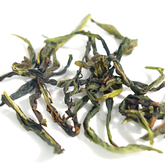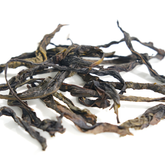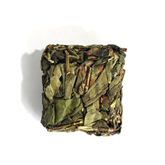How Much Loose Leaf Tea Per Cup: A Beginner's Guide to Perfect Tea Brewing.
Drinking tea is incredibly healthy, as tea is a natural plant-based beverage without any added artificial flavors or colors. Because of this, many beginners have started falling in love with tea. However, when newcomers first get their tea, they are often unsure how much loose leaf tea to use, leading to confusion.
Some even give up on tea because they don't know how to brew it properly, resulting in overly bitter tea. This leaves them with a bad impression of tea's flavor. 
Many tea brewing guides simply state that you should use 2-3 grams of green tea or 3-4 grams of black tea. But this advice is misleading, as it overlooks the size of the teaware being used. Should a large 600ml teapot and a small 200ml cup really use the same amount of loose leaf tea? Today, we’ll discuss the topic of how much loose leaf tea to use.
Factors Affecting Tea Amount
It's important to note that the larger the teapot, the more tea leaves you should use. Otherwise, the tea will be too weak. Conversely, if you're using a small cup, you should reduce the amount of tea to avoid bitterness. If you're brewing tea in a glass, where the tea is steeping continuously, use a smaller amount of loose leaf tea. Start with a small amount and adjust based on the tea's strength. If the tea is too weak, you can always add more next time, finding the perfect balance.
Regardless of the type of tea you're brewing, remember not to use too much tea at first. Start with a smaller amount and adjust as needed—this approach is foolproof.
Loose Leaf Tea Measurements for Beginners
To help beginners get a better grasp of tea amounts, we’ve summarized the typical loose leaf tea-to-water ratios for the six major types of Chinese tea (using gaiwans and Yixing clay teapots). You can adjust these proportions to suit your personal taste, but remember that experienced tea drinkers often brew stronger tea than beginners might prefer. Their method isn’t wrong; it’s just based on years of tailoring their brew to their own tastes, which may not be suitable for newcomers.
Green Tea and Yellow Tea
Tea-to-water ratio: 1:50
Green teas like Longjing and Jasmine tea are delicate and release their flavors quickly. When using a gaiwan, add just enough loose leaf tea to cover the bottom of the cup. For Longjing tea, the typical ratio is 1 gram of tea per 50ml of water, with the water temperature around 85°C. Avoid covering the cup to keep the tea fresh and sweet.
Black Tea
Tea-to-water ratio: 1:50
Similar to green tea, black tea usually follows a ratio of 1:50 but can be a bit stronger. Larger-leaf black teas may need slightly more leaves than smaller-leaf varieties. For broken leaf black tea, reduce the tea amount by one-third, as it infuses quickly. It’s recommended to brew black tea at a slightly lower temperature than boiling to avoid bitterness.
Oolong Tea
Tea-to-water ratio: 1:25
Oolong tea requires the most tea leaves, with some varieties like Da Hong Pao or Rougui filling up half or even two-thirds of the teapot. Ball-shaped oolongs like Tie Guan Yin or Taiwanese High Mountain Oolong require fewer leaves. Since oolong is a semi-fermented tea, boiling water helps to release its fragrance and flavor. For high mountain oolongs, boiling water is essential to experience the full aroma.
Pu-erh Tea, Dark Tea, White Tea
Tea-to-water ratio: 1:30
For loose leaf teas, use more tea, while for compressed cakes, use less. Both Pu-erh and dark teas should be brewed with boiling water and rinsed before drinking. Aged ripe Pu-erh or dark teas may even need two rinses. White tea, which is light and fluffy, requires a larger volume to fill the gaiwan. Loose leaf white tea should fill about three-quarters or half of the gaiwan, while compressed white tea cakes should take up around one-fifth of the vessel.
Do You Really Need a Tea Ceremony?
Beginners can skip the complicated tea brewing rituals—these ceremonies don’t actually affect your ability to enjoy a good cup of tea. For those who are new to tea, the most important thing is to enjoy the process, not to get caught up in elaborate steps or traditional formalities. In reality, it’s the quality of the tea leaves, the tea-to-water ratio, water temperature, and steeping time that truly determine the taste of your tea. While tea rituals carry cultural charm, they don’t directly improve the flavor. As long as you understand the key points of tea brewing, even the simplest method can produce a delicious cup of tea.
In reality, it’s the quality of the tea leaves, the tea-to-water ratio, water temperature, and steeping time that truly determine the taste of your tea. While tea rituals carry cultural charm, they don’t directly improve the flavor. As long as you understand the key points of tea brewing, even the simplest method can produce a delicious cup of tea.
No Gaiwan or Teapot?
If you're not familiar with Gongfu tea brewing, don’t own a gaiwan or teapot, or simply feel that traditional tea brewing is too complicated or might burn your hands, using a glass cup to brew loose leaf tea is a perfectly simple and effective alternative. For most high-quality Chinese teas, the glass brewing method works surprisingly well. The key is to control how much tea you use—keep the tea leaves to a minimum and lower the water temperature, ideally to around 80°C (176°F). This helps limit the release of tea polyphenols, reducing bitterness. This method is especially great for green tea, white tea, and yellow tea—lighter or non-fermented teas. Brewing these in a glass not only saves time, but also allows you to enjoy the beautiful color of the tea liquor and the unfolding of the tea leaves.
For most high-quality Chinese teas, the glass brewing method works surprisingly well. The key is to control how much tea you use—keep the tea leaves to a minimum and lower the water temperature, ideally to around 80°C (176°F). This helps limit the release of tea polyphenols, reducing bitterness. This method is especially great for green tea, white tea, and yellow tea—lighter or non-fermented teas. Brewing these in a glass not only saves time, but also allows you to enjoy the beautiful color of the tea liquor and the unfolding of the tea leaves.
That said, for more heavily fermented teas like oolong tea,dark tea and ripe Pu-erh, it's still recommended to use a gaiwan or a Yixing clay teapot. These traditional teaware options are better suited to fully release the complex aromas and layered flavors of these richer teas.
Conclusion
SEE MORE CHINESE TEAS
If you have questions about selecting tea:
Learn-more-about-chinese-tea
If you have questions about the benefits of tea:
Health-benefits-of-chinese-tea
If you have questions about brewing tea:
How-to-brew-loose-leaf-tea







